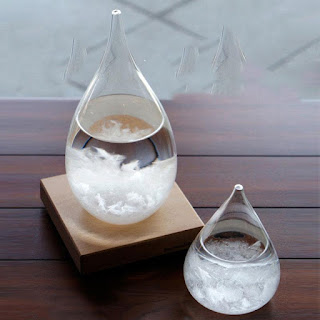You can not feel the approach of the imminent storms, but time causes changes in the atmosphere that affect the chemical reactions. You can use your chemistry command to make a storm glass to help predict the weather.
Stormglass materials
2.5 g of potassium nitrate
2.5 g of ammonium chloride
33 ml of distilled water
40 ml of ethanol
10 g of natural camphor
How to make Stormglass
Dissolve potassium nitrate and ammonium chloride in water.
Dissolve camphor in ethanol.
Add the solution of potassium nitrate and ammonium chloride to the camphor solution. You may need to warm up the solutions to get them mixed up.
Place the mixture in a clogged test tube or seal it in the weather predicting storm glass. To seal the glass, apply heat to the top of the tube until it softens and tilts the tube so that the glass edges melt together. If a plug is used, it is a good idea to pack it with parafilm or wax it to ensure a good seal.
How to interpret stormglass
Clear liquid - time should be clear and clear
Cloudy liquid - the weather can be cloudy, perhaps with precipitation
Small dots in the liquid - potentially wet or foggy weather
Cloudy liquid with small stars - thunderstorms or snow, depending on temperature
Large flakes dispersed in the liquid - overcast, possibly with rain or snow
Crystals in the bottom - gel
Son near the summit - wind
How does storm glass work
The premise of storm glass operation is that temperature and pressure affect solubility, sometimes resulting in a clear liquid; other times causing the formation of precipitants. In similar barometers, the liquid level rises or falls in a tube in response to atmospheric pressure.
Sealed glasses are not exposed to pressure changes that would explain much of the observed behavior. Some people have suggested that the surface interactions between the glass wall of the barometer and the liquid content represent the crystals. Explanations sometimes include effects of electricity or quantum tunneling through the glass.
History of storm glass
This type of weather predicting storm glass was used by Robert FitzRoy, the captain of HMS Beagle during Charles Darwin's trip. FitzRoy acted as a meteorologist and hydrologist for the trip. FitzRoy said that "Storm Glasses" were made in England for at least a century before it was published in 1863 as The Weather Book... He had begun studying glasses in 1825. FitzRoy described their properties and noted that there was a great variation in the operation of glasses, depending on the formula and the method used to create them. The basic formula of the liquid of a good storm glass consisted of camphor, partially dissolved in alcohol, with water, ethanol and a little air. FitzRoy insisted that the glass had to be hermetically sealed, not open to the outside environment.

No comments:
Post a Comment